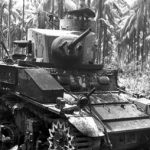James (always known as Jim) Astley-Rushton was born in 1911 and destined to follow his father, an Admiral, into the Royal Navy.
But his eyesight was not up to the exacting standard require. Instead, he joined, after Harrow and a degree in French at Cambridge and a term at the Sorbonne, the 7th Hussars in Cairo in 1935 just as they were exchanging their horses for tanks.
By the somewhat perverse logic of the times, an Arts degree was considered a good qualification for the new job of Regimental Technical Adjutant, to which Jim was appointed.
In the early days of the desert war, shortages of spares for the Mk VIB and later models of tanks, with which the Regiment was equipped, were always a problem, exacerbated by the high mileage covered in the fluctuating battles in the desert and the battle damage. Several battle reports bear witness to Jim’s near genius in scrounging spares and delivering them to the Regimental Fitters working on the damaged tanks.
In the fluid battles of the desert, this was a dangerous task with the possibility in the open spaces of running into the enemy. But Jim always had the maximum possible number of tanks fit for battle.
He was awarded a Mention in Despatches for his work.
After the devastating battle of Sidi Rezegh, when only eight of the 55 tanks that went into battle were left fit, the Regiment was withdrawn to re-equip with the American Stuart tanks provided under the lease-lend agreement.
After only a pause of some seven weeks the Regiment embarked for Burma, where, as part of the 7th Armoured Brigade, they covered the fighting withdrawal against the Japanese, the longest retreat in the history of the British Army.
Yet again, Jim was responsible for keeping the tanks fit, helped this time by the reliability of the Stuart tank. With the Japanese closing in, only one tank was able to be ferried across the river Chindwin while all the others had to be destroyed. The remaining 140 miles to India, therefore, had to be covered on foot.
It was then that Jim’s exceptionally strong physique and stamina helped many to survive who would not have otherwise done so.
He was awarded a second Mention in Despatches.
This extraordinary effort, however, took its toll and on arrival in India, Jim was in hospital and convalescing for many months.
Jim returned to the Regiment as Headquarters Squadron Leader in early 1947 where he soon became a model for the intake of young officers – efficient yet compassionate, modest, unobtrusively generous, and an enthusiastic horseman.
In 1973 he became a much admired Second-in-Command. In 1974 he transferred to the Royal Military Police, where, after a distinguished career in his new Corps, he retired as a full Colonel in 1963.
Jim married Joan in August 1946. She pre-deceased him. They had two sons, Justin and Julius.
Jim remained a loyal 7th Hussar all his life, always attending Regimental functions whenever he could. He will be remembered as a kind and wise friend.



